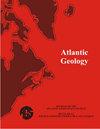Sedimentology and chemostratigraphy of Carboniferous red beds in the western Moncton Basin, Sussex area, New Brunswick, Canada: possible evidence for a middle Mabou Group unconformity
IF 0.9
4区 地球科学
Q2 GEOLOGY
引用次数: 2
Abstract
The area around Penobsquis, east of Sussex, New Brunswick, Canada, is an important location of natural resources for the province. The McCully gas field produces from strata of the Mississippian Horton Group whereas younger strata of the Windsor Group are host to major potash and rocksalt deposits. Overlying these units are over 1 km of poorly understood red beds currently assigned to the Mississippian Mabou Group. To date, this latter unit lacks significant marker beds and has had no useful biostratigraphic recovery, despite recent extraction of close to 5 km of drill core. Research on this core broadly identifies siltstone and sandstone at the base of the Mabou Group that gradually coarsen up into conglomerate. The succession is considered the result of alluvial-fan progradation from the northeast. Within this succession, in several of the cores, is a single interval of localized, horizontally laminated to cross-stratified, bluish-grey sandstone, containing carbonaceous plant fragments and siltstone intraclasts. To assess the importance of this interval in the context of the red bed succession, a total of 131 samples of core from three boreholes have been analyzed using Inductively Coupled Plasma and spectroscopic techniques to determine chemostratigraphy. Study of various elemental ratios can delineate two packages, one that corresponds to the grey interval and overlying red beds, and the other to the underlying red beds. Changes in the elemental ratios are interpreted to mark a broader population of mineral species related to greater variation of provenance and diagenesis in the upper sediment package. The reduced horizons and rip-up clasts may have been produced by sediment reworking along a boundary that represents an unconformity (in core, a disconformity) at a stratigraphic level near to where one has been inferred by other workers.加拿大新不伦瑞克省苏塞克斯地区蒙克顿盆地西部石炭系红层沉积学与化学地层学:马布群中部不整合的可能证据
加拿大新不伦瑞克省苏塞克斯以东的佩诺布斯周边地区是该省重要的自然资源所在地。McCully气田产自密西西比霍顿群地层,而温莎群的年轻地层则是主要钾盐和岩盐矿床的所在地。在这些单元之上,有超过1公里的红色层,目前被划分为密西西比Mabou群。到目前为止,后一个单元缺乏重要的标志层,尽管最近提取了近5公里的钻芯,但没有有用的生物地层恢复。该岩心研究广泛识别了马窝群底部粉砂岩和砂岩,并逐渐粗化为砾岩。这种演替被认为是东北冲积扇进积的结果。在这个演替中,在几个岩心中,有一个局部的、水平层状到交叉层状的蓝灰色砂岩的单一间隔,含有碳质植物碎片和粉砂岩内碎屑。为了评估该层段在红层演为背景下的重要性,利用电感耦合等离子体和光谱技术分析了来自三个钻孔的131个岩心样本,以确定化学地层学。对不同元素比例的研究可以描绘出两个包,一个对应于灰色区间和上覆的红色层,另一个对应于下伏的红色层。元素比率的变化被解释为标志着更广泛的矿物种群,这与上部沉积物包体中物源和成岩作用的更大变化有关。降低的层位和撕裂的碎屑可能是由于沉积物沿着代表不整合的边界(在岩心中,是不整合)在地层水平附近被其他工人推断出来的地方重新加工而产生的。
本文章由计算机程序翻译,如有差异,请以英文原文为准。
求助全文
约1分钟内获得全文
求助全文
来源期刊

Atlantic Geology
GEOLOGY-
CiteScore
2.10
自引率
18.80%
发文量
0
审稿时长
>12 weeks
期刊介绍:
Atlantic Geology (originally Maritime Sediments, subsequently Maritime Sediments and Atlantic Geology) covers all aspects of the geology of the North Atlantic region. It publishes papers, notes, and discussions on original research and review papers, where appropriate to the regional geology.
 求助内容:
求助内容: 应助结果提醒方式:
应助结果提醒方式:


